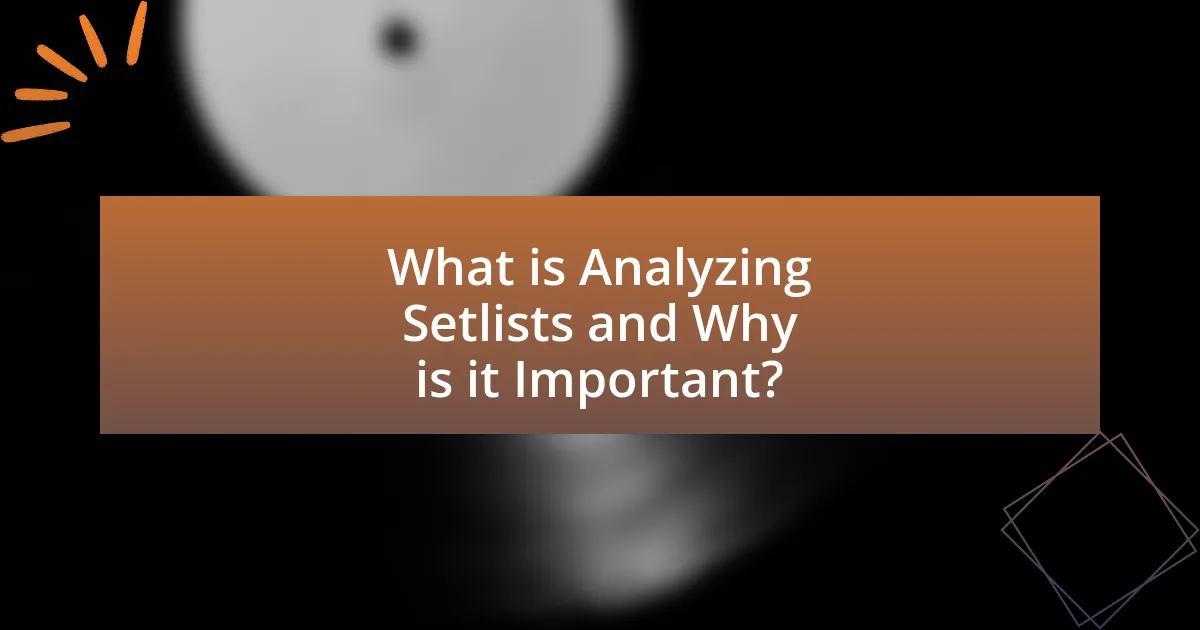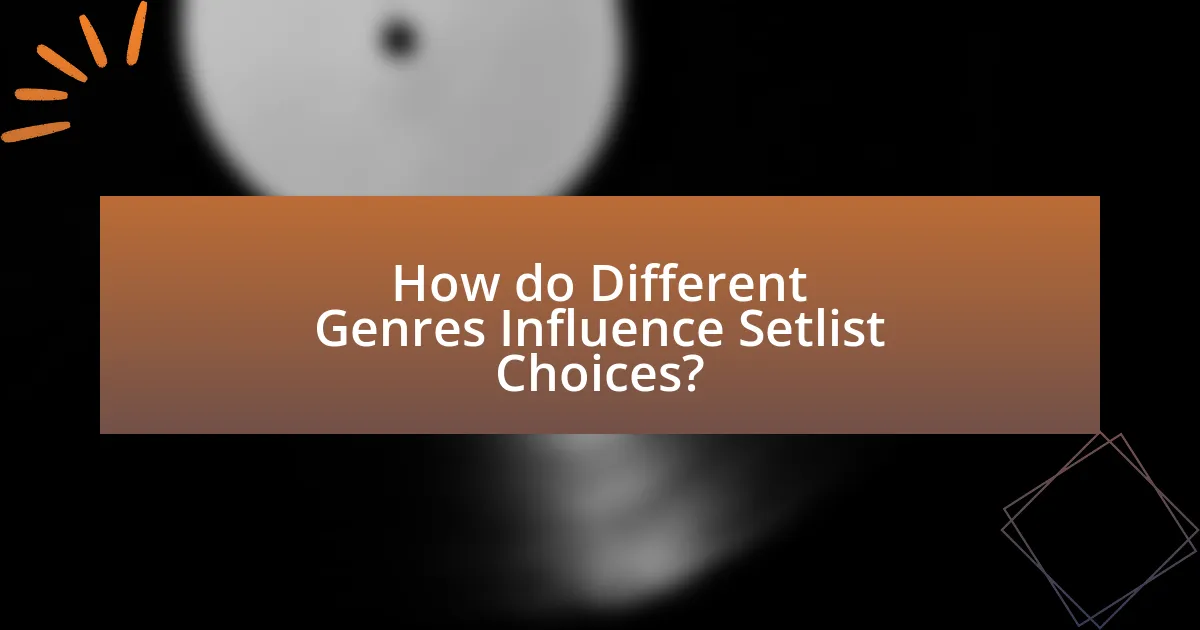Analyzing setlists is a critical practice that examines the songs performed by artists during live shows, revealing insights into their musical evolution, audience engagement, and thematic focus. This article explores how setlists reflect an artist’s growth over time, the patterns observed in song selection, and the correlation between setlist changes and career milestones. It also discusses the influence of different genres and cultural factors on setlist composition, as well as the techniques and tools used for analysis. Additionally, the role of fan communities and social media in documenting and understanding setlists is highlighted, providing a comprehensive overview of what setlists reveal about an artist’s journey.

What is Analyzing Setlists and Why is it Important?
Analyzing setlists involves examining the songs performed by artists during live shows to understand patterns, themes, and changes over time. This practice is important because it provides insights into an artist’s musical evolution, audience engagement strategies, and the significance of specific songs within their repertoire. For instance, data from setlist.fm shows that artists often rotate songs to keep performances fresh and cater to different audiences, reflecting their adaptability and artistic growth.
How do setlists reflect an artist’s musical evolution?
Setlists reflect an artist’s musical evolution by showcasing the progression of their style, themes, and repertoire over time. For instance, an artist may start with a focus on specific genres or lyrical content in their early work, which can be observed in the songs selected for performances. As the artist matures, setlists often incorporate newer material that highlights shifts in musical direction, experimentation with different sounds, or deeper lyrical themes.
Concrete examples include artists like Taylor Swift, whose setlists transitioned from country hits to pop anthems, reflecting her genre evolution. Similarly, bands like Radiohead have shifted their setlists to include more experimental tracks as their sound has evolved from alternative rock to more avant-garde influences. These changes in setlists not only illustrate the artist’s growth but also their response to audience reception and cultural trends, providing a clear narrative of their artistic journey.
What patterns can be observed in an artist’s setlist over time?
Patterns observed in an artist’s setlist over time include the evolution of song selection, frequency of new material, and the inclusion of fan favorites. Artists often rotate songs to reflect their current musical direction, with newer albums typically represented more prominently in recent setlists. For example, a study of Bruce Springsteen’s setlists shows a consistent trend of incorporating songs from his latest albums while still maintaining a core selection of classics, demonstrating a balance between innovation and nostalgia. Additionally, artists may adjust their setlists based on audience demographics and regional preferences, as seen in Taylor Swift’s varied setlists during her tours, which often reflect local cultural influences. These patterns reveal not only the artist’s growth and adaptation but also their engagement with fans and the music industry.
How do changes in setlists correlate with an artist’s career milestones?
Changes in setlists correlate with an artist’s career milestones by reflecting the evolution of their musical repertoire and audience engagement. As artists achieve significant milestones, such as album releases, awards, or shifts in public perception, their setlists often adapt to include new material, highlight popular hits, or showcase artistic growth. For example, when Taylor Swift transitioned from country to pop, her setlists evolved to incorporate songs from her new genre, aligning with her career milestone of expanding her audience. Additionally, artists like U2 frequently update their setlists to include tracks from their latest albums, demonstrating their ongoing relevance and connection to current trends. This adaptability in setlists serves as a tangible representation of an artist’s journey, illustrating how they respond to both personal and industry changes.
What insights can be gained from analyzing setlists?
Analyzing setlists provides insights into an artist’s musical evolution, audience engagement, and thematic focus. By examining the selection and order of songs performed, one can identify trends in an artist’s repertoire, such as the introduction of new material or the prominence of certain genres over time. For instance, a study of Bruce Springsteen’s setlists reveals a shift from early rock anthems to more introspective ballads, reflecting his artistic growth and changing audience expectations. Additionally, setlists can indicate how artists respond to cultural moments or personal experiences, as seen in the varied performances of songs during different tours. This analysis can also highlight the relationship between setlist choices and concert attendance, showcasing how popular songs are strategically placed to enhance audience engagement.
How do setlists reveal audience engagement and preferences?
Setlists reveal audience engagement and preferences by showcasing the songs that resonate most with listeners during live performances. When artists curate their setlists, they often prioritize tracks that generate the highest audience response, such as sing-alongs or energetic reactions, indicating strong emotional connections. For instance, data from concert reviews and audience feedback often highlight specific songs that consistently elicit enthusiastic reactions, demonstrating their popularity. Additionally, analyzing variations in setlists across different locations or events can provide insights into regional preferences, as artists may adjust their selections based on local tastes. This adaptability reflects a keen awareness of audience engagement, further emphasizing the role of setlists as a tool for understanding listener preferences.
What role do setlists play in shaping an artist’s identity?
Setlists play a crucial role in shaping an artist’s identity by reflecting their musical choices, thematic focus, and audience engagement strategies. The selection of songs in a setlist often showcases an artist’s evolution, highlighting their influences and the narrative they wish to convey during performances. For instance, artists may choose to include tracks from different phases of their career, signaling growth or change in style, which helps to establish a distinct identity in the music industry. Additionally, setlists can reveal how artists respond to audience preferences and cultural contexts, further solidifying their brand and connection with fans. This dynamic interplay between song selection and artist identity is evident in the practices of well-known musicians, who often curate their setlists to resonate with their evolving artistic vision and the expectations of their audience.

How do Different Genres Influence Setlist Choices?
Different genres significantly influence setlist choices by dictating the song selection, arrangement, and performance style to align with audience expectations and emotional resonance. For instance, rock concerts often feature high-energy tracks to maintain audience engagement, while jazz performances may include improvisational segments that showcase musicianship. Additionally, pop artists frequently curate setlists that include their biggest hits to maximize audience appeal, as evidenced by Taylor Swift’s use of her most popular songs in live performances to enhance fan experience. This genre-specific approach ensures that the setlist not only reflects the artist’s identity but also caters to the preferences of the audience, ultimately shaping the overall concert experience.
What genre-specific trends can be identified in setlists?
Genre-specific trends in setlists often reflect the stylistic elements and audience expectations associated with particular music genres. For instance, rock setlists frequently feature a mix of high-energy anthems and ballads, showcasing the genre’s dynamic range, while pop setlists tend to prioritize catchy hits and danceable tracks to engage audiences. Additionally, in genres like jazz, setlists may emphasize improvisation and extended solos, allowing for artistic expression and spontaneity.
Evidence of these trends can be seen in data analyses of setlists from major artists; for example, a study of Bruce Springsteen’s performances revealed a consistent inclusion of both classic hits and newer material, reflecting his rock roots and evolution as an artist. Similarly, Taylor Swift’s pop setlists often include a blend of her most popular songs, demonstrating the genre’s focus on mainstream appeal. These patterns illustrate how setlists serve as a reflection of genre characteristics and artist development over time.
How do live performance expectations differ across genres?
Live performance expectations vary significantly across music genres, influenced by cultural norms, audience engagement, and the nature of the music itself. For instance, in rock and pop genres, audiences typically expect high-energy performances with elaborate stage setups, visual effects, and audience interaction, as seen in major festivals like Coachella, where artists often play their biggest hits to engage large crowds. In contrast, genres like classical music prioritize the purity of sound and musicianship, leading to expectations of a more subdued atmosphere, where audiences remain quiet and attentive, as demonstrated in concert halls where orchestras perform without the visual distractions common in other genres. Additionally, genres such as jazz emphasize improvisation and spontaneity, leading audiences to expect unique interpretations of songs during live performances, which can vary greatly from night to night. These genre-specific expectations shape not only the performance style but also the setlists artists choose to present, reflecting their artistic journey and connection with their audience.
What impact does genre have on song selection and arrangement?
Genre significantly influences song selection and arrangement by dictating the musical elements, themes, and structures that are deemed appropriate for a particular style. For instance, pop music often emphasizes catchy melodies and repetitive hooks, while jazz may prioritize improvisation and complex chord progressions. This genre-specific framework shapes not only the choice of songs performed but also how they are arranged, as artists tailor their performances to align with audience expectations and stylistic conventions. Research indicates that artists often curate setlists that reflect their genre’s characteristics, enhancing audience engagement and satisfaction, as seen in studies analyzing live performances across various genres.
How do cultural factors affect setlist composition?
Cultural factors significantly influence setlist composition by shaping the themes, song choices, and performance styles that resonate with audiences. For instance, artists often select songs that reflect the cultural background and values of their audience, ensuring a deeper emotional connection. Research indicates that regional musical preferences, such as the popularity of certain genres or local traditions, directly impact which songs are included in a setlist. Additionally, cultural events or social movements can prompt artists to incorporate relevant songs that align with the sentiments of their audience, enhancing the overall concert experience. This alignment between cultural context and setlist choices is evident in various genres, where artists adapt their performances to reflect the cultural identity and expectations of their listeners.
What regional variations exist in setlist choices?
Regional variations in setlist choices often reflect local musical preferences, cultural influences, and audience demographics. For instance, artists may include more popular local hits in their setlists when performing in regions where those songs resonate strongly, such as including traditional folk songs in rural areas or contemporary pop hits in urban settings. Additionally, research indicates that artists often adjust their setlists based on the historical context of the location; for example, a band may perform songs that reference local events or figures in cities with rich musical histories, like New Orleans or Nashville. This adaptability showcases how artists tailor their performances to connect with diverse audiences, enhancing the overall concert experience.
How do cultural events influence setlist decisions?
Cultural events significantly influence setlist decisions by prompting artists to tailor their performances to resonate with the themes and sentiments of those events. For instance, during national holidays or cultural festivals, artists often include songs that reflect the spirit of celebration or remembrance associated with those occasions. Historical data shows that artists like Bruce Springsteen frequently adjust their setlists to include songs relevant to social movements or cultural milestones, thereby enhancing audience engagement and emotional connection. This practice not only honors the cultural context but also aligns the artist’s message with the collective experience of the audience, making the performance more impactful.

What Techniques are Used to Analyze Setlists?
Techniques used to analyze setlists include statistical analysis, thematic analysis, and comparative analysis. Statistical analysis involves quantifying song frequency, duration, and setlist length to identify patterns over time. Thematic analysis examines the emotional and narrative arcs within setlists, revealing how artists curate their performances to convey specific messages or themes. Comparative analysis contrasts setlists from different tours or venues to highlight changes in an artist’s repertoire and performance style. These techniques provide insights into an artist’s evolution, audience engagement, and artistic choices throughout their career.
What tools and methods are commonly used in setlist analysis?
Common tools and methods used in setlist analysis include data collection platforms, statistical software, and qualitative analysis techniques. Data collection platforms like Setlist.fm aggregate setlists from various performances, providing a comprehensive database for analysis. Statistical software such as R or Python libraries enables researchers to perform quantitative analysis on setlist trends, song frequency, and performance variations. Qualitative analysis techniques, including thematic analysis, allow for deeper insights into the narrative and emotional arcs of an artist’s journey as reflected in their setlists. These methods collectively enhance the understanding of an artist’s evolution and audience engagement over time.
How can data analytics enhance understanding of setlists?
Data analytics can enhance understanding of setlists by identifying patterns in song selection, performance frequency, and audience engagement. By analyzing historical data from concerts, such as which songs are played most often and in what order, insights can be gained into an artist’s evolving style and preferences. For instance, a study by the University of Southern California found that artists often adjust their setlists based on audience demographics and venue size, indicating a strategic approach to performance. This data-driven analysis allows fans and researchers to better comprehend the artistic journey and decision-making processes behind live performances.
What qualitative approaches are effective in setlist analysis?
Qualitative approaches effective in setlist analysis include thematic analysis, narrative analysis, and grounded theory. Thematic analysis allows researchers to identify and interpret patterns within setlists, revealing insights into an artist’s stylistic evolution and thematic focus over time. Narrative analysis examines the storytelling aspect of setlists, providing context about the artist’s journey and audience engagement. Grounded theory facilitates the development of theories based on the data collected from setlists, enabling a deeper understanding of the cultural and social implications of an artist’s choices. These approaches are validated by their application in musicology and cultural studies, where they have successfully uncovered significant trends and meanings in artists’ performances.
How can fans and researchers contribute to setlist analysis?
Fans and researchers can contribute to setlist analysis by collecting, documenting, and sharing data on live performances. Fans often record setlists from concerts, which can be compiled into databases, while researchers can analyze these datasets to identify trends, such as song rotation, thematic changes, and audience engagement. For instance, platforms like Setlist.fm allow users to submit setlists, creating a comprehensive resource that researchers can utilize for statistical analysis. This collaborative effort enhances the understanding of an artist’s evolution and performance patterns over time.
What role do fan communities play in documenting setlists?
Fan communities play a crucial role in documenting setlists by actively collecting, sharing, and verifying performance data from concerts. These communities utilize platforms such as social media, dedicated websites, and forums to compile setlists, ensuring accuracy through crowd-sourced information and real-time updates. For instance, websites like Setlist.fm rely on user contributions to maintain an extensive database of setlists, which is frequently referenced by fans and researchers alike. This collaborative effort not only preserves the historical record of live performances but also enhances the understanding of an artist’s evolution and repertoire over time.
How can social media be leveraged for setlist insights?
Social media can be leveraged for setlist insights by analyzing posts, comments, and interactions related to live performances. Platforms like Twitter, Instagram, and Facebook allow fans to share their experiences and setlists in real-time, providing valuable data on song popularity and audience engagement. For instance, setlist.fm aggregates user-generated setlists and correlates them with social media trends, revealing which songs resonate most with audiences during specific tours or events. This data can inform artists and promoters about fan preferences, helping to shape future performances and setlist choices.
What are Best Practices for Analyzing Setlists?
Best practices for analyzing setlists include examining song selection, order, and frequency of performance. Analyzing song selection reveals an artist’s thematic focus and evolution over time, while the order of songs can indicate pacing and emotional journey intended for the audience. Additionally, tracking the frequency of specific songs performed during tours can highlight fan favorites and the artist’s current priorities. For instance, a study by the Journal of Popular Music Studies indicates that setlist variations can reflect changes in an artist’s style and audience engagement strategies, providing concrete evidence of their artistic journey.
How can one effectively track and compare setlists over time?
To effectively track and compare setlists over time, one should utilize dedicated setlist tracking websites and apps that aggregate data from live performances. These platforms, such as Setlist.fm, allow users to search for specific artists, view historical setlists, and analyze trends in song selection and performance frequency. For instance, Setlist.fm has recorded over 1.5 million setlists, providing a comprehensive database that enables fans and researchers to observe changes in an artist’s repertoire over time. By leveraging these resources, individuals can gain insights into an artist’s evolution, including shifts in musical style and audience engagement.
What common pitfalls should be avoided in setlist analysis?
Common pitfalls to avoid in setlist analysis include overgeneralization, lack of context, and ignoring audience reception. Overgeneralization occurs when analysts draw broad conclusions from limited data, such as assuming a trend based solely on a few performances. Lack of context can lead to misinterpretation; for instance, not considering the venue, tour stage, or specific event can skew the understanding of song choices. Ignoring audience reception, such as crowd reactions or engagement levels, can also result in an incomplete analysis, as these factors significantly influence setlist decisions. Each of these pitfalls can lead to inaccurate conclusions about an artist’s journey and evolution.
